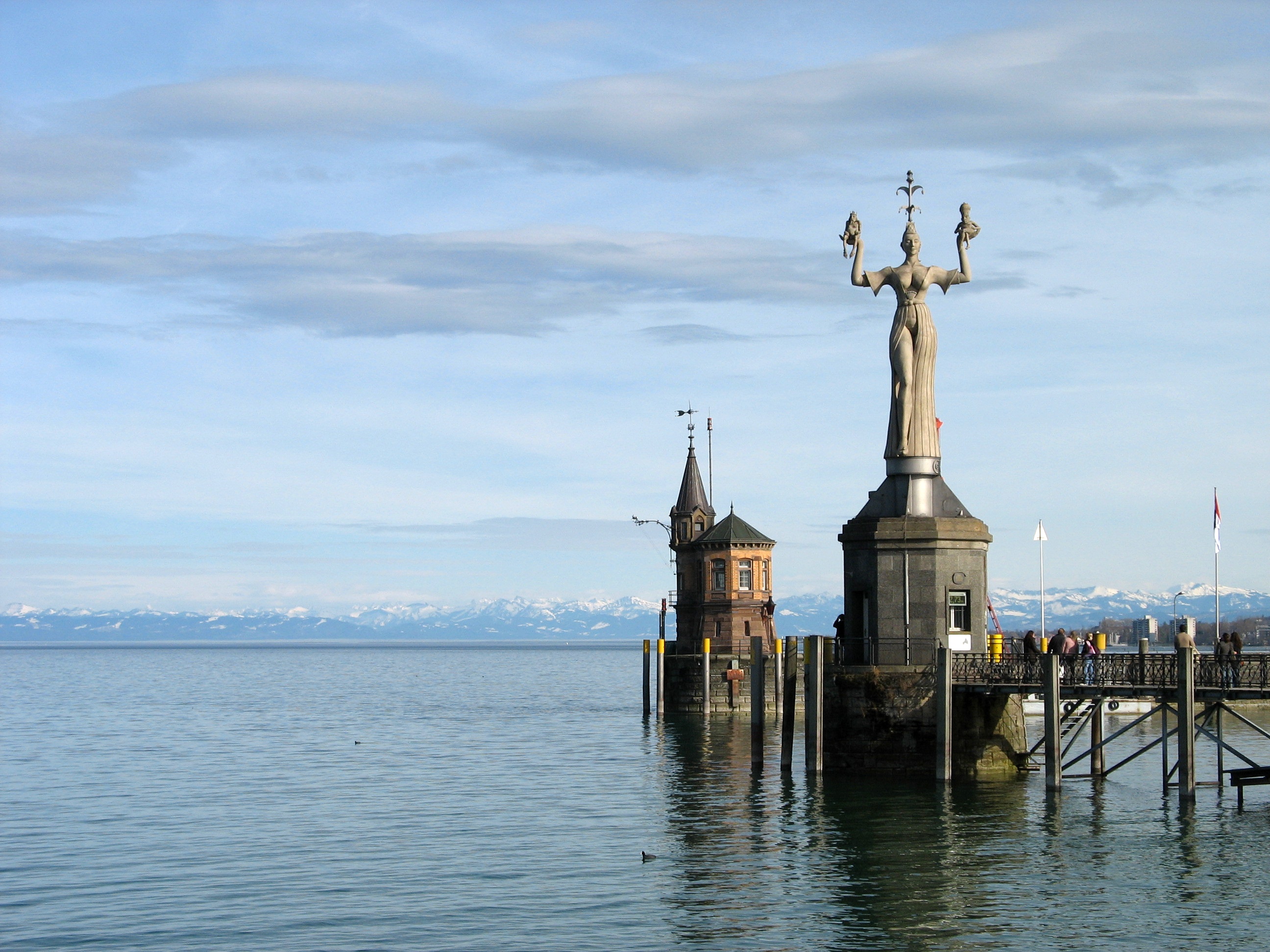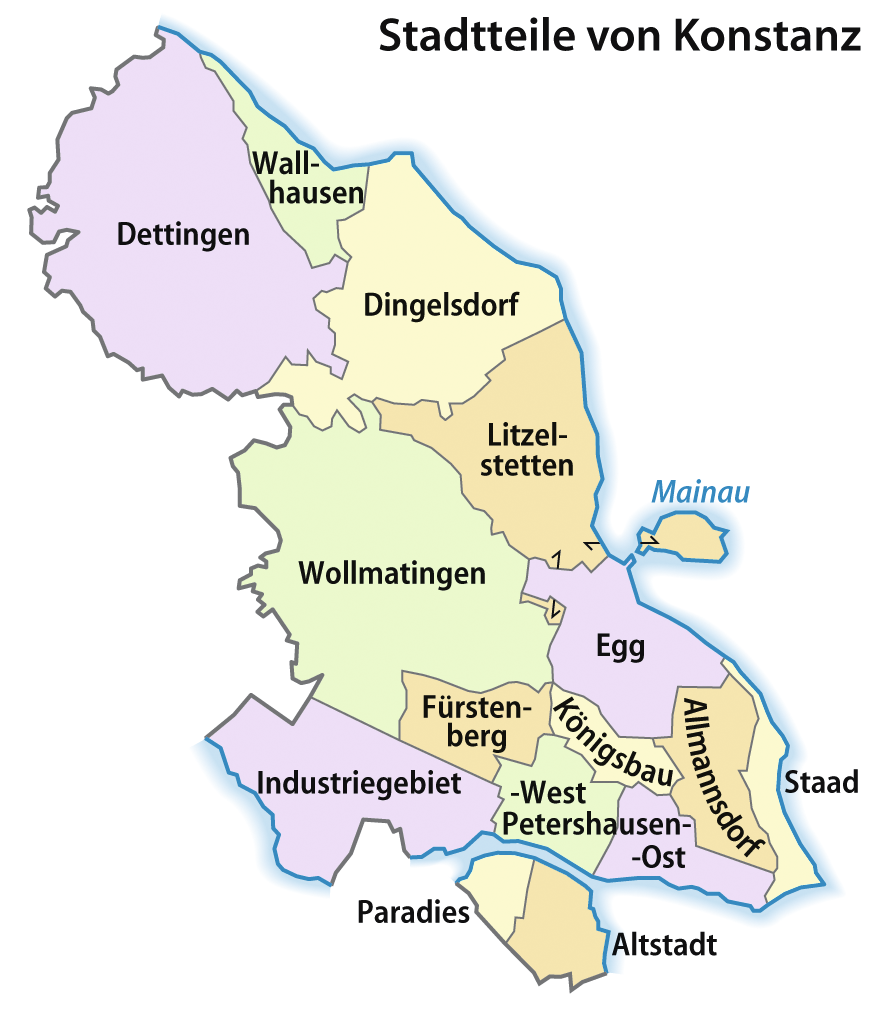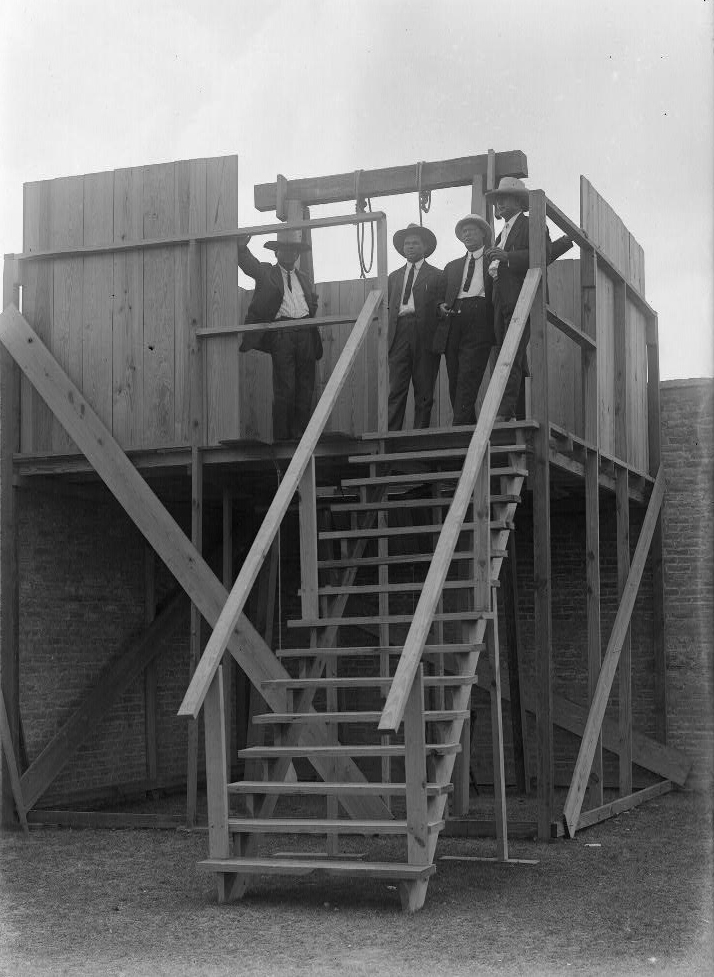|
Tägermoos
The Tägermoos is an area of 1.54 km2 (380 acres) in Thurgau, Switzerland, wedged between the outskirts of the German city of Constance and the core village of the Swiss municipality of Tägerwilen. It lies on the south bank of the Seerhein. In the east, it borders the district Paradies of Constance. In the south-east, it borders the district Emmishofen of the municipality of Kreuzlingen. The remarkable status of Tägermoos was fixed in 1831 by a treaty which is still in force today. Under this treaty, the area is part of Switzerland at the state level and part of the Swiss municipality of Tägerwilen. However, certain administrative tasks are exercised by the German city of Constance, in accordance with Thurgau municipal law. Other tasks are exercised by the authorities of Tägerwilen. In particular, land survey is the responsibility of Constance, making Tägermoos a of the city of Constance. The City of Constance legally owns about two-thirds of the land; the ... [...More Info...] [...Related Items...] OR: [Wikipedia] [Google] [Baidu] |
Seerhein
The Seerhein ("Lake Rhine") is a river about four kilometres long, in the basin of Lake Constance. It is the outflow of the Upper Lake Constance and the main tributary of the Lower Lake Constance. The water level of the lower lake is about 30 cm below the level of the Upper Lake. It is considered part of the Rhine, which flows into Lake Constance as the Alpine Rhine and flows out of the Lake as the High Rhine. The Seerhein arose after the last ice age (the Würm glaciation, about 9650 BCE). Some time after this period, the water level of Lake Constance gradually dropped by about ten metres and the shallow parts fell dry. Some parts of the Seerhein still have a character a bit like a lake. The border between Germany and Switzerland runs down the center of the lower stretch of the river; the German city of Constance, the largest community on the river, is situated on both sides of the upper part. Location General The Seerhein extends over a length of 4.3 km f ... [...More Info...] [...Related Items...] OR: [Wikipedia] [Google] [Baidu] |
Tägerwilen
Tägerwilen is a municipality in the district of Kreuzlingen in the canton of Thurgau in Switzerland. Geography Tägerwilen has an area, , of . Of this area, or 47.5% is used for agricultural purposes, while or 37.4% is forested. Of the rest of the land, or 14.4% is settled (buildings or roads), or 0.3% is either rivers or lakes and or 0.5% is unproductive land.Swiss Federal Statistical Office-Land Use Statistics 2009 data accessed 25 March 2010 Of the built up area, industrial buildings made up 6.4% of the total area while housing and buildings made up 1.0% and transportation infrastructure made up 0.5%. Power and water infrastructure as well as other special developed areas made up 1.8% of the area while parks, green belts and sports fields ma ... [...More Info...] [...Related Items...] OR: [Wikipedia] [Google] [Baidu] |
Konstanz
Konstanz (, , locally: ; also written as Constance in English) is a university city with approximately 83,000 inhabitants located at the western end of Lake Constance in the south of Germany. The city houses the University of Konstanz and was the residence of the Roman Catholic Diocese of Konstanz for more than 1,200 years. Location The city is located in the state of Baden-Württemberg and situated at the banks of Lake Constance (''Bodensee'' in German). The river Rhine, which starts in the Swiss Alps, passes through Lake Constance and leaves it, considerably larger, by flowing under a bridge connecting the two parts of the city. North of the river lies the larger part of the city with residential areas, industrial estates, and the University of Konstanz; while south of the river is the old town, which houses the administrative centre and shopping facilities in addition to the ''Hochschule'' or the ''University of Applied Sciences''. Car ferries provide access across Lake Con ... [...More Info...] [...Related Items...] OR: [Wikipedia] [Google] [Baidu] |
Paradies (Constance)
Paradies (literally: "paradise") is a former village, now a quarter of Konstanz, Germany. The district is located west of the Old Town on the southern shore of the Seerhein; with an area of about 63.2 hectare (, to be exact) and 6176 inhabitants (2007 census). In the Late Middle Ages, it was a fishing and farming village called ''Eggehusen''. Its original centre was the St Leonard's Chapel erected in the 14th century at the site of a former Poor Clares monastery with the name ''claustrum Paradysi apud Constantiam'' founded in 1186. In 1253 the nuns left their convent on the outskirts of Konstanz and moved to Schlatt near Schaffhausen; while the name ''Paradies'' stuck. The chapel was rebuilt in 1921, it today is consecrated to St Martin. In 1610, about 300 people were living in Paradies. The farmers in Paradies supplied the inhabitants of the city from their fields on the open space between the current federal road B 33 (Europe Street) and the city walls. Paradies then was ... [...More Info...] [...Related Items...] OR: [Wikipedia] [Google] [Baidu] |
Switzerland
). Swiss law does not designate a ''capital'' as such, but the federal parliament and government are installed in Bern, while other federal institutions, such as the federal courts, are in other cities (Bellinzona, Lausanne, Luzern, Neuchâtel, St. Gallen a.o.). , coordinates = , largest_city = Zürich , official_languages = , englishmotto = "One for all, all for one" , religion_year = 2020 , religion_ref = , religion = , demonym = , german: Schweizer/Schweizerin, french: Suisse/Suissesse, it, svizzero/svizzera or , rm, Svizzer/Svizra , government_type = Federalism, Federal assembly-independent Directorial system, directorial republic with elements of a direct democracy , leader_title1 = Federal Council (Switzerland), Federal Council , leader_name1 = , leader_title2 = , leader_name2 = Walter Thurnherr , legislature = Fe ... [...More Info...] [...Related Items...] OR: [Wikipedia] [Google] [Baidu] |
Jurisdiction
Jurisdiction (from Latin 'law' + 'declaration') is the legal term for the legal authority granted to a legal entity to enact justice. In federations like the United States, areas of jurisdiction apply to local, state, and federal levels. Jurisdiction draws its substance from international law, conflict of laws, constitutional law, and the powers of the executive and legislative branches of government to allocate resources to best serve the needs of society. International dimension Generally, international laws and treaties provide agreements which nations agree to be bound to. Such agreements are not always established or maintained. The exercise of extraterritorial jurisdiction by three principles outlined in the UN charter. These are equality of states, territorial sovereignty and non-intervention. This raises the question of when can many states prescribe or enforce jurisdiction. The ''Lotus'' case establishes two key rules to the prescription and enforcement of jurisdi ... [...More Info...] [...Related Items...] OR: [Wikipedia] [Google] [Baidu] |
Scots Abbey
Scots usually refers to something of, from, or related to Scotland, including: * Scots language, a language of the West Germanic language family native to Scotland * Scots people, a nation and ethnic group native to Scotland * Scoti, a Latin name for the Gaels * SCOTS, abbreviation for Royal Regiment of Scotland * Scottish Corpus of Texts and Speech (SCOTS), a linguistic resource See also * Southern Culture on the Skids (SCOTS), an American rock band * Scot's Lo-Cost, a grocery store owned by Weis Markets * Scotch (other) * Scots Church (other) * Scots College (other) * Scott's (other) * Scottish (other) * Scotts (other) * Pound Scots The pound (Modern and Middle Scots: ''Pund'') was the currency of Scotland prior to the 1707 Treaty of Union between the Kingdom of Scotland and the Kingdom of England, which created the Kingdom of Great Britain. It was introduced by David I, ..., historical currency * Scots pine, ... [...More Info...] [...Related Items...] OR: [Wikipedia] [Google] [Baidu] |
Gallows
A gallows (or scaffold) is a frame or elevated beam, typically wooden, from which objects can be suspended (i.e., hung) or "weighed". Gallows were thus widely used to suspend public weighing scales for large and heavy objects such as sacks of grain or minerals, usually positioned in markets or toll gates. The term was also used for a projecting framework from which a ship's anchor might be raised so that it is no longer sitting on the bottom, i.e., "weighing heanchor,” while avoiding striking the ship’s hull. In modern usage it has come to mean almost exclusively a scaffold or gibbet used for execution by hanging. Etymology The term "gallows" was derived from a Proto-Germanic word '' galgô'' that refers to a "pole", "rod" or "tree branch". With the beginning of Christianization, Ulfilas used the term ''galga'' in his Gothic Testament to refer to the cross of Christ, until the use of the Latin term (crux = cross) prevailed. Forms of hanging Gallows can take several f ... [...More Info...] [...Related Items...] OR: [Wikipedia] [Google] [Baidu] |
Brickyard
A brickyard or brickfield is a place or yard where bricks are made, fired, and stored, or sometimes sold or otherwise distributed from. Brick makers work in a brick yard. A brick yard may be constructed near natural sources of clay or on or near a construction site if necessity or design requires the bricks to be made locally. Brickfield and Brickfields became common place names for former brickfields in south east England. See also * Brickworks, another type of place where bricks are made, often on a larger scale, and with mechanization * Clay pit, a quarry or mine for clay * Kiln A kiln is a thermally insulated chamber, a type of oven, that produces temperatures sufficient to complete some process, such as hardening, drying, or chemical changes. Kilns have been used for millennia to turn objects made from clay int ..., the type of high heat oven that bricks are baked in References Sources * External links * Bricks {{Manufacturing-stub ... [...More Info...] [...Related Items...] OR: [Wikipedia] [Google] [Baidu] |
Imperial Free City
In the Holy Roman Empire, the collective term free and imperial cities (german: Freie und Reichsstädte), briefly worded free imperial city (', la, urbs imperialis libera), was used from the fifteenth century to denote a self-ruling city that had a certain amount of autonomy and was represented in the Imperial Diet. An imperial city held the status of Imperial immediacy, and as such, was subordinate only to the Holy Roman Emperor, as opposed to a territorial city or town (') which was subordinate to a territorial princebe it an ecclesiastical lord ( prince-bishop, prince-abbot) or a secular prince (duke ('), margrave, count ('), etc.). Origin The evolution of some German cities into self-ruling constitutional entities of the Empire was slower than that of the secular and ecclesiastical princes. In the course of the 13th and 14th centuries, some cities were promoted by the emperor to the status of Imperial Cities ('; '), essentially for fiscal reasons. Those cities, which had b ... [...More Info...] [...Related Items...] OR: [Wikipedia] [Google] [Baidu] |
Bailiwick
A bailiwick () is usually the area of jurisdiction of a bailiff, and once also applied to territories in which a privately appointed bailiff exercised the sheriff's functions under a royal or imperial writ. The bailiwick is probably modelled on the administrative organization which was attempted for a very small time in Sicily and has its roots in the official state of the Hohenstaufen. In English, the original French ''bailie'' combined with '-wic', the Anglo-Saxon suffix (meaning a village) to produce a term meaning literally 'bailiff's village'—the original geographic scope of a bailiwick. In the 19th century, it was absorbed into American English as a metaphor for a sphere of knowledge or activity. The term survives in administrative usage in the British Crown Dependencies of the Channel Islands, which are grouped for administrative purposes into two bailiwicks — the Bailiwick of Jersey (comprising the island of Jersey and uninhabited islets such as the Minquiers ... [...More Info...] [...Related Items...] OR: [Wikipedia] [Google] [Baidu] |
Low Justice
High, middle and low justices are notions dating from Western feudalism to indicate descending degrees of judicial power to administer justice by the maximal punishment the holders could inflict upon their subjects and other dependents. Low justice regards the level of day-to-day civil actions, including voluntary justice, minor pleas, and petty offences generally settled by fines or light corporal punishment. It was held by many lesser authorities, including many lords of the manor, who sat in justice over the serfs, unfree tenants, and freeholders on their land. Middle justice would involve full civil and criminal jurisdiction, except for capital crimes, and notably excluding the right to pass the death penalty, torture and severe corporal punishment, which was reserved to authorities holding high justice, or the ''ius gladii'' ("right of the sword"). Pyramid of feudal justice Although the terms ''high'' and ''low'' suggest a strict subordination, this was not quite the case ... [...More Info...] [...Related Items...] OR: [Wikipedia] [Google] [Baidu] |








